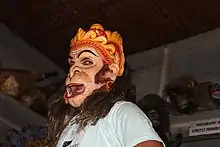
Mask art of Assam, Assam has a long tradition of mask making, it developed in the response to Neo–Vaisnavism, initiated by Srimanta Sankardeva in the 15th century. These masks were developed for it to be used in the Bhaona's (Traditional drama of Assam). The art of making masks was prevalent in Satras for centuries, presently the Samaguri Satra is world-famous for its mask crafts.[1]

These masks or (Mukha) are of various kinds like– Mukh mukha (mask covering the face), Bor mukha (mask+costume, covers whole of the body), and Suti Su Mukha (smaller than Bor muka, but more compact) and are made of biodegradable materials such as bamboo, cane, potter's clay (Kumar mati), cow dung, jute fiber, paper cloth etc.[2] It usually takes a period of 10 to 15 days to make one mask and traditionally hengul and haital were used for colouring the masks, but presently due to inavailability of those materials water-colour and chemical dyes are also in use.[3][4] Till recent decades, the masks were stiff and didn't allow the actor to portray any facial expression but innovations brought by Dr. Hemachandra Goswami has changed this. Despite its cultural significance, it is not widely embraced. This art is only prevalent in Upper Assam, especially in Majuli island, and only managed to survive in a plenty of Satras. [5]
Notes
- ↑ "Mask Making Tradition of Assam". blog.mygov.in. Retrieved 2023-05-10.
- ↑ "Traditional Mask Making Culture of Majuli". INDIAN CULTURE. Retrieved 2023-05-10.
- ↑ "Colourful masks of Assam". Deccan Herald. 2013-02-19. Retrieved 2023-05-10.
- ↑ "A world of masks in Assam's Majuli island". The Tribune.
- ↑ "The Mask-Making Tradition of Assam". Sahapedia. Retrieved 2023-05-10.
Further reading
- Bordoloi, Saswati D. "'Mukha': The Mask Tradition of Assam-with Special Reference to Samaguri Sattra". Cultural Syndrome: 20–34.
- Vaidhya, Ranjan Kumar (2009). Art Approaches Of Majuli An Analytical Study of Illustrated Manuscripts, Mask Making and Wood Carvings. p. 173–192.